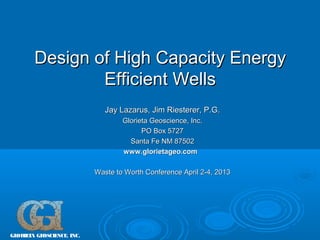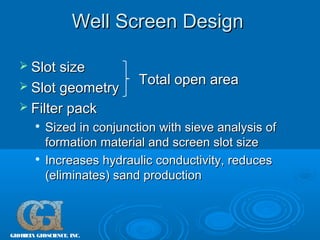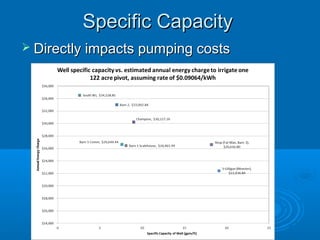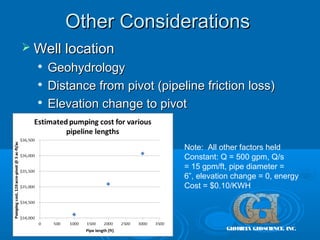Design of High Capacity Energy Efficient Wells
- 1. Design of High Capacity Energy Efficient Wells Jay Lazarus, Jim Riesterer, P.G. Glorieta Geoscience, Inc. PO Box 5727 Santa Fe NM 87502 www.glorietageo.com Waste to Worth Conference April 2-4, 2013 GLORIE A GE T OSCIENCE INC. ,
- 2. Efficient Water Use At Dairies ’āś Agriculture is the largest user of groundwater in the United States ’āś Ground water at dairies used for cow drinking, milking parlor clean-up and crop irrigation is produced from wells that often are often improperly designed and completed. ’āś Inefficient well design results in increased pumping costs and increases the frequency that wells and/or pumps have to be replaced. ’āś Inefficient wells require significantly more energy to pump lesser amounts of water than properly designed wells.
- 3. Well Drilling GLORIE A GE T OSCIENCE INC. ,
- 4. Types of Wells ’āś Domestic ’āś Municipal ’āś Commercial ’āś Irrigation GLORIE A GE T OSCIENCE INC. ,
- 5. Types of screen ’āś Torch cut ’āś Plasma cut ’āś Saw cut (PVC) ’āś Mill slot ’āś Wire wrapped ’āś Louvered Photo from johnsonscreens.com GLORIE A GE T OSCIENCE INC. ,
- 6. Well Efficiency Inefficient well: Efficient well: ŌĆóLimited open area ŌĆóMaximize open area ŌĆóIncorrect/no filter pack ŌĆóProper filter pack ŌĆóScreens get dewatered ŌĆóScreens are not dewatered ŌĆóPumps sand and/or air ŌĆóDoes not pump sand and/or air ŌĆóOversized pump motor ŌĆóProperly sized pump motor ŌĆóArtificially high total dynamic head ŌĆóMinimizes total dynamic head
- 7. Why is Well Efficiency Important? ’āś Energy cost savings ’āś An efficient, sand-free well will save a farmer significant money on energy costs to produce the water and the well and pump lifetime will be extended significantly. GLORIE A GE T OSCIENCE INC. ,
- 8. When Does a Pump Fail? ’āś When you need it the mostŌĆ”.. ’āś During the hottest time of the irrigation seasonŌĆ”.. ’āś When the pump contractor is servicing a municipal well for a bigger clientŌĆ”.. GLORIE A GE T OSCIENCE INC. ,
- 9. Why Does a Pump Fail? ’āś Old Age ’āś Excessive sand production ’āś Excessive drawdown ’ü¼ Water not cooling the pump effectively ’ü¼ Air entrainment ’āĀ Cavitation ’āś OtherŌĆ” GLORIE A GE T OSCIENCE INC. ,
- 10. What Causes Sand Production? ’āś Improper screen/filter pack sand sizes ’āś Casing failure (bad welds, corrosion) GLORIE A GE T OSCIENCE INC. ,
- 11. Screen Placement ’āś Best production intervals ’āś Allow sufficient water column above screen to prevent dewatering screens ’ü¼ Include margin for long-term drawdown GLORIE A GE T OSCIENCE INC. ,
- 12. Well Screen Design ’āś Slot size ’āś Slot geometry Total open area ’āś Filter pack ’ü¼ Sized in conjunction with sieve analysis of formation material and screen slot size ’ü¼ Increases hydraulic conductivity, reduces (eliminates) sand production GLORIE A GE T OSCIENCE INC. ,
- 13. Well Development ’āś Removes drilling fluid from filter pack and formation (increases production) ’āś Removes fines from filter pack, properly grades filter pack and formation for long term sand-free production GLORIE A GE T OSCIENCE INC. , Photo from Driscoll, 1986
- 14. Specific Capacity ’āś Defined as production rate per unit of drawdown (Q/s) ’ü¼ Typically expressed as gpm/ft ’ü¼ The bigger the number the better the well ’āś Allows well to be designed in a manner that will avoid dewatering screens ’ü¼ Often must estimate Q/s in design phase based on nearby wells or lithologic analogues ’ü¼ Confirm actual Q/s with test pump prior to selecting permanent pump GL IE A GE OR T OSCIENCE INC. ,
- 15. Specific Capacity ’āś Directly impacts pumping costs
- 16. Maximizing Specific Capacity ’āś Proper screen and filter pack selection ’āś Proper screen locations ’āś Proper well development ’āś Up front costs associated with these items can easily be recouped in power savings and pump longevity GLORIE A GE T OSCIENCE INC. ,
- 17. Maximizing Pump Efficiency ’āś Must have good specific capacity (step drawdown) test at a minimum to select best pump for the job ’āś Select permanent pump AFTER step test is conducted ’āś Oversizing the pump requires choking back flow, creating artificial and unnecessary head (and increased pumping costs) GLORIE A GE T OSCIENCE INC. ,
- 19. Using the Step Test Results
- 20. 7 Day Drawdown Test
- 21. Maximizing Pump Efficiency 800 80 ~71 % eff. 700 70 50 hp ~62 % eff. 600 60 40 hp 500 50 Assumed 400 30 hp 40 % n e y c ) ( Eff i 300 30 20 hp Step test m Result H D To d e n a c y ) ( f t i l 200 20 10 hp 100 10 0 0 0 100 200 300 400 500 600 Capacity (gpm) If pump is selected based on the assumed flow and head, the pump will be oversized and actual operation will be ~9% less efficient and discharge will have to be choked back creating an additional ~80 ft of artificial head.
- 22. Maximizing Pump Efficiency ’āś In our example*, a 9% reduction in pump efficiency and an extra 80 ft of head translates to a cost increase of approximately $9200/year for one pivot. *Q = 500 gpm, Q/s = 15 gpm/ft, Pipe diameter = 6ŌĆØ, pipe length = 1000 ft, power cost = $0.10/KWH GLORIE A GE T OSCIENCE INC. ,
- 23. Other Considerations ’āś Well location ’ü¼ Geohydrology ’ü¼ Distance from pivot (pipeline friction loss) ’ü¼ Elevation change to pivot Note: All other factors held Constant: Q = 500 gpm, Q/s = 15 gpm/ft, pipe diameter = 6ŌĆØ, elevation change = 0, energy Cost = $0.10/KWH GLORIE A GE T OSCIENCE INC. ,
- 24. Other Considerations ’āś Pipeline sizes ’ü¼ Properly sized pipes can significantly reduce friction loss/pumping costs Note: All other factors held Constant: Q = 500 gpm, Q/s = 15 gpm/ft, pipe length = 1000ŌĆÖ, elevation change = 0, Energy cost = $0.10/KWH GLORIE A GE T OSCIENCE INC. ,
- 25. Summary and Conclusions ’āś Significant operational cost savings (power, pump replacement) can be realized through properly: ’āś Selecting screen size/geometry ’āś Locating screened intervals ’āś Selecting filter pack size ’āś Developing the well ’āś Testing the well ’āś Maximizing pump efficiency ’āś Sizing pipelines ’āś Minimizing pipe runs where possible GLORIE A GE T OSCIENCE INC. ,
- 26. Questions? www.glorietageo.com lazarus@glorietageo.com riesterer@glorietageo.com GLORIE A GE T OSCIENCE INC. ,


























